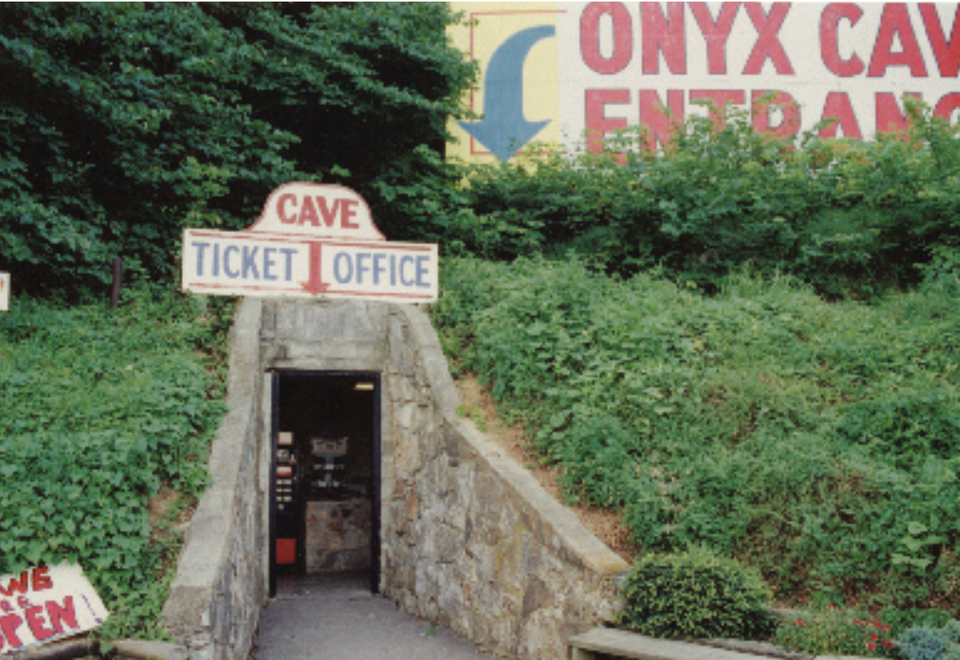
Onyx Cave in Kentucky, catches tourists off the Interstate heading to nearby Mammoth Cave with its large billboard and plain portal. Center for Land Use Interpretation, Subterranean Renovations: The Unique Architectural Spaces of Show Caves, 1998, CLUI Archive photo
Congratulations are in order for Matthew Coolidge, director of the Center for Land Use Interpretation (CLUI) and winner of the 2006 SAAM Lucelia Artist Award. The Center is a bold choice, if only for the obvious fact that an institution is a tricky pick for an artist award. But that’s what makes Coolidge’s organization such a compelling project—CLUI straddles the borders distinguishing artist and collective, observer and activist, micro and macro.
CLUI is a research organization broadly dedicated to the examination of the nation’s land use—a landscape art for the information age. To that end, CLUI has established a variety of programs and projects, including the American Land Museum (an association of satellite regional centers, which develop informational resources specific to their regions) and Land Use Database (a central depository for data regarding land use, organized by geographic region and state as well as by categorical use). In addition, CLUI has published ten books and maintains an image archive used by various publications.
Jurors met a few weeks back to discuss and review the Lucelia finalists. The jury included Pamela Lee (Stanford art history professor), Christian Marclay (artist), James Rondeau (curator, Art Institute of Chicago), Linda Shearer (director, Contemporary Arts Center in Cincinnati), and Nancy Spector (curator and director, Guggenheim). Notably, the jurors highlighted the fact that Coolidge and CLUI do not “polemicize the issues,” given the unavoidable political dimension of the work.
See the Whitney Biennial for a clear-cut illustration of what the jurors mean. This year's Biennial has a didactic and political tone, but the CLUI touchscreen information kiosk stands out as an "artwork" that comments on politicized environmental issues in a sophisticated way. It is aggressively political art but does not read like the stuff that often passes as political art. Unfortunately, the CLUI kiosk does not stand alone, and it's easy to miss in the jumble of the installation.
I raise the point about the Whitney specifically to illustrate how CLUI is presented, which might not be obvious from a description of the organization. The closest cousin Coolidge has in the art world might be Hans Haacke, and it’s fair to describe Coolidge as a conceptual artist; like Haacke, CLUI mostly dispenses with made objects (they do maintain a large photographic archive), instead presenting the idea as the subject and thing itself. CLUI even dispels the notion of a single, identifiable artist at work.
That said, I prefer to think of CLUI as a contemporary take on landscape art. Much in the way that Smithson advanced the American sublime landscape painting, Coolidge/CLUI have also advanced the form. It’s as if the stakes have been raised—given the realities of global warming and resource consumption, it’s fair to say that they have—and Coolidge/CLUI respond to the changing environment with an “advanced” landscape art. CLUI is decentered, like the threats imperiling the environment (i.e., there’s no single responsible individual for either). CLUI aggregates photographs as opposed to shooting them. And the data-gathering processes at the center of the project represent a new technology for understanding and representing the world.
After ancient landscape art came landscape painting; after landscape painting came landscape photography; after landscape photography came landscape installations. It’s not clear yet whether landscape data represents the next step in the succession, but Coolidge and CLUI are making the case for it.


















